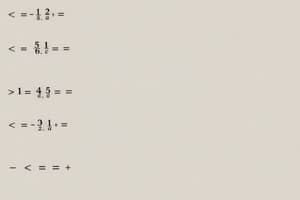Podcast
Questions and Answers
What is a fraction?
What is a fraction?
- A way to express a decimal as a ratio of two integers
- A way to express a part of a whole as a ratio of two integers (correct)
- A way to express a whole as a single number
- A way to express a whole as a ratio of two decimals
What is the purpose of finding a common denominator when adding or subtracting fractions?
What is the purpose of finding a common denominator when adding or subtracting fractions?
- To make the denominators the same (correct)
- To find the greatest common divisor
- To make the numerators the same
- To simplify the fractions
What is the result of multiplying two fractions?
What is the result of multiplying two fractions?
- A fraction with a smaller numerator and denominator
- A fraction with the sum of the numerators and denominators
- A fraction with the product of the numerators and denominators (correct)
- A fraction with a larger numerator and denominator
What is an improper fraction?
What is an improper fraction?
What is the first step in dividing fractions?
What is the first step in dividing fractions?
Flashcards are hidden until you start studying
Study Notes
Definition and Basics
- A fraction is a way to express a part of a whole as a ratio of two integers: numerator (top number) and denominator (bottom number)
- Examples: 1/2, 3/4, 2/3
Key Concepts
- Equivalent Fractions: fractions that have the same value but different numbers
- Example: 1/2 = 2/4 = 3/6
- Simplifying Fractions: reducing a fraction to its simplest form by dividing both numerator and denominator by their greatest common divisor (GCD)
- Example: 6/8 = 3/4 (simplified)
- Improper Fractions: fractions where the numerator is greater than the denominator
- Example: 3/2, 5/3
- Mixed Numbers: a combination of a whole number and a proper fraction
- Example: 2 1/2, 3 3/4
Operations with Fractions
- Adding and Subtracting Fractions:
- Find a common denominator (LCD) for the two fractions
- Add or subtract the numerators and keep the common denominator
- Multiplying Fractions:
- Multiply the numerators and denominators separately
- Simplify the resulting fraction
- Dividing Fractions:
- Invert the second fraction (i.e., flip the numerator and denominator)
- Multiply the first fraction by the inverted second fraction
- Simplify the resulting fraction
Studying That Suits You
Use AI to generate personalized quizzes and flashcards to suit your learning preferences.




